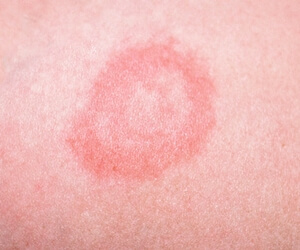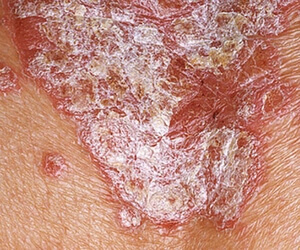Psoriasis is characterized by periods of remission and exacerbation. Inflammation of the skin takes place in several stages: initial, progressive, stationary, regressive. This separation will help in diagnosis and proper therapy.
Interesting to know
Psoriasis is a genetic disease. About 10% of the population has characteristic DNA disorders, and only 2% of them show signs of skin disorders.
The following factors cause pathology:
- strong emotional stress;
- injuries;
- alcohol abuse, smoking;
- unbalanced diet;
- infectious and other diseases;
- certain drugs; endocrine diseases;
- predisposition to allergies;
Due to the wrong response of the immune system, which reacts to the epidermal tissues as foreign elements, the first signs of the disease appear. Consider the stages of psoriasis, its symptoms and treatment regimens.

Initial stage of psoriasis
The first sign isacne(papules). Rounded, reddish or pink. Due to the slow blood flow, manifestations of a bluish tint may appear on the lower limbs. Papular formations are small, the size of a pinhead.
The early stage is characterized bymany papulesthat have well-defined borders. Whitish scales also appear. They are easily separated from the surface by touch. Papules can merge into one, forming larger elements.
During early remission, the lesions turn pale. The affected areas of the skin are partially discolored. In children, this stage of psoriasis is often confused with manifestations of allergy or diathesis. The rash may be accompanied by severe itching. Signs that can be used to diagnose psoriasis:
- when scraped, the surface of the plaque becomes whitish, resembles a rubbed drop of stearin, the scales flake off;
- if you continue to scrape the stain and remove the scale, a shiny red surface will appear;
- Small drops of blood appear when scraping.
Progressive phase of psoriasis
During the progressive phase of psoriasis, the following symptoms appear:
- The papules turn red, continuing to be covered with white scales. They peel with ease, underneath you can see a smooth layer of reddened skin. When it is damaged, blood appears.
- As it gets worse, the papular elements grow, merge. They are clearly different from healthy areas of the skin.
- Itching burns. But it goes through the transition of the process to a stationary phase. Painful and obsessive itching that interferes with sleep and daily activities. If you just scratch the lid, injuries and new tiles will appear. The appearance of new plaques at the site of injury is Koebner syndrome. The number of manifestations of itching gradually increases, covering the body, limbs, head.
- There are no scales on the edges of the plaque, they are hyperemic, which indicates the continuation of the inflammatory process.
Consequences
Psoriasis can adversely affect the joints (psoriatic arthritis). Then there are severe pains in the joints, their deformation, if the process goes untreated.
Stationary stage of psoriasis
The main feature of the stationary stage of psoriasis is that new elements stop appearing. Positive changes come with the right treatment.

Clinical manifestations:
- the itching disappears;
- no injuries (Koebner's symptom disappears);
- peeling may increase.
All places stop evolving. If during the progressive phase the tiles had a flake-free edge, then during the stationary phase the entire inflamed surface of the cover will peel off, taking on a characteristic psoriatic appearance.
Shells are characteristic of the last stage of inflammation. At the beginning of the development of the pathology, the scales do not keep pace with the progressive growth of plaque and cannot completely cover them. In half of the cases, apseudoatrophic corollaappears.
Pseudoatrophic wreath
It looks like a light rim around an element, which has a structure reminiscent of coarse tissue paper, consisting of a stratum corneum and not exceeding two millimeters in width.
Regressive stage of psoriasis
In the regressive phase of psoriasis, the psoriatic cycle ends. Highlights:
- the process of aggravation ceases, the inflammation passes;
- plaques gradually dissolve;
- peeling ceases, elements of rash are flattened;
- rash becomes pale pink, gradually changing color;
- papules can still remain on the arms and elbows.
There are no scars or atrophy of the affected area. Temporary hyperpigmentation or areas without pigment may appear at the site of the rash.
Remission occurs after complex therapy.The relief period is individual. Latent illness can last for months or even years. Exacerbations occur more often in winter, with the exception of only a few forms of psoriasis.
Treatment of psoriasis in different stages
Therapy of any form of psoriasis consists of general and local treatment, physiotherapy methods and dietary adjustments. In the early phase of therapy it is necessary:
- give up bad habits;
- strictly adhere to the therapeutic diet;
- use fats that contain vitamins A, D3, hormones;
- use systemic and sedative drugs;
- undergo ultraviolet therapy.
If plaques are located on the head, the doctor prescribes shampoos based on tar, zinc and selenium sulfide.
All products must be used according to the doctor's instructions. Prolonged use of medications (especially with tar) can irritate the skin. Funds should be changed every 7 days.
Early treatment of psoriasis
The effectiveness of early treatment interventions depends on when the patient goes to the doctor and starts treatment.
Early therapy in most cases helps prevent the disease from turning into a chronic form.
Experts recommend the use of ointments with salicylic acid. It is an anti-inflammatory and antimicrobial drug that has a beneficial effect on the affected areas of the skin. With the help of keratolytic effect, the ointment will clean the plaque from keratinized parts of the skin.Naphthalene ointment will help relieve itching.
Medications are usually prescribed:
tar-based- ;
- based on solid oil;
- oil based.
Not so long ago there were drops and oils for psoriasis. The tool is able to soothe the skin, moisturize it, prevent the skin from drying out and alleviate swelling. The preparation contains ubiquinone, beta-carotene, beaver fat, propolis, pumpkin seed oil and other components, with the help of which the number of plaques is reduced, they become smaller, the skin is better hydrated. It is recommended to be used in combination with other medications and after consultation with a specialist.
Treatment of advanced psoriasis
Therapy should be comprehensive and careful. The clinical picture is quite difficult, treatment should be trusted only by experts. Patients are helped by intravenous and intramuscular administration of special drugs. Sorbents help remove toxins from the body.
Manifestations remove salicylic acid ointment, emulsions for softening. Moisturizes and reduces inflammation. During exacerbations, tar medications or other irritating components should not be used.
Physiotherapy procedures (PUVA therapy, ultraviolet radiation, paraffin application) are best performed during the period of inflammation reduction. Corticosteroids and cytostatics are prescribed only when the processes are particularly complex.
Prescribe antihistamines (reduce the development of allergic reactions), sedatives (sedatives), anti-inflammatory, keratolytics (emollients), diuretics (relieve swelling, remove toxins).
Treatment of inpatient psoriasis
The patient needs a slight correction of therapy. Shampoos with tar, emulsions with oil, calcipotriol are usually prescribed. Systemic therapy is used when the disease affects large areas of integrity. Ultraviolet radiation and PUVA technique are widely used.
If there is no effect, some cytotoxic drugs are prescribed. In severe cases, the patient is prescribed an immunosuppressant, cytotoxic.
Treatment of regressive psoriasis
Therapy in the final stage of psoriasis should be comprehensive, tailored by experts. Therapy is gradually discontinued, replaced by preventive measures. The treatment is carried out carefully at all stages, in no case should the rash be damaged.
It is especially important to follow the strictest diet and make lifestyle adjustments. Stress can be a strong provoking factor, which significantly worsens the condition at the beginning of the disease.
In combination with drug therapy, the rash on the hands can be treated with baths with sea salt or mixed baby cream with powder series, lubricate with plaque this mixture.
Additional therapies
A patient with psoriasis has a lack of vitamins that affect the regulation of metabolic processes, have a purifying, sedative and restorative effect.
Vitamin complex should contain B vitamins, ascorbic acid, vitamin A, folic acid and others. They are prescribed internally, intramuscularly and also in drops.
The division of pathology into different phases is a conditional measure that helps professionals to correctly identify a particular phase, facilitating diagnosis and treatment. It is impossible to completely get rid of psoriasis, but if all the rules of complex treatment are followed, with systematic preventive measures, the disease can be latent for a long time and not interfere with a person's life completely.























